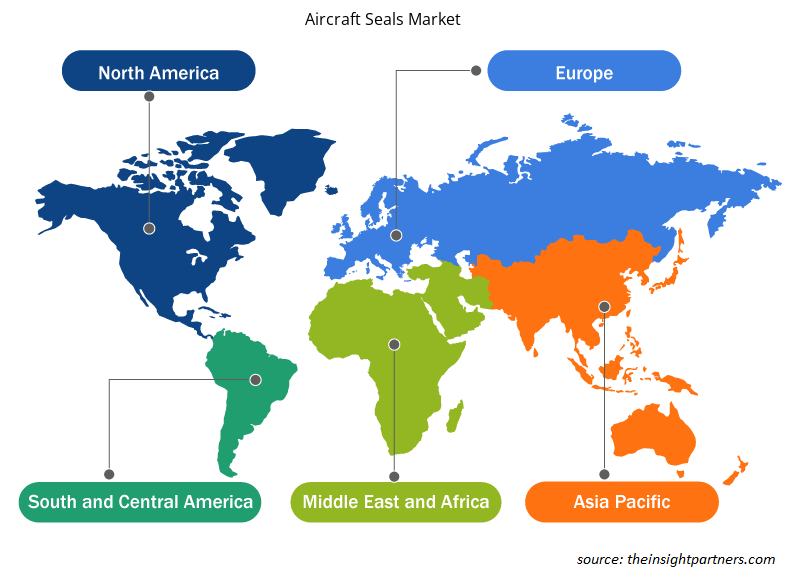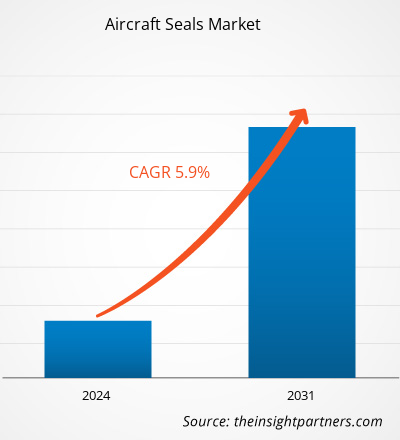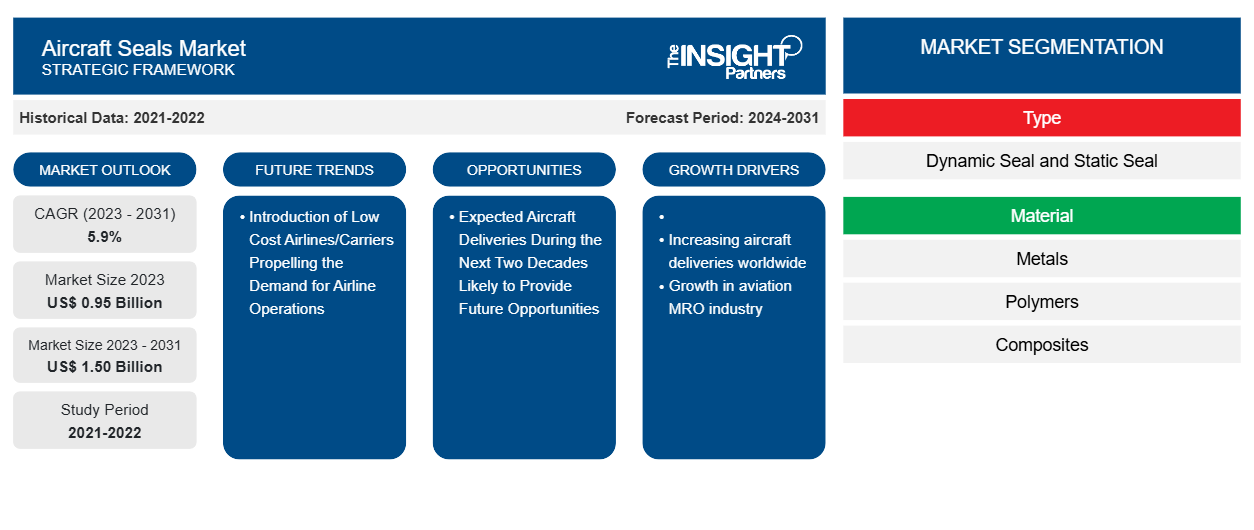预计到 2031 年,飞机密封件市场规模将从 2023 年的 9.5 亿美元增至 15 亿美元。预计 2023-2031 年市场复合年增长率将达到 5.9%。随着轻质耐用材料的出现和迅速普及,航空业正变得越来越复杂。传统类型的密封件是使用硬化金属制造的;然而,在过去几年中,飞机和飞机部件制造商以及飞机运营商都在寻求轻质密封件,例如聚合物密封件和复合材料密封件。这一因素反映了对聚合物和复合材料密封件的更高需求,从而推动了市场的发展。
飞机密封件市场分析
飞机订单和生产量的不断增长,通过 OEM 部分支持了飞机密封件市场的增长。另一方面,售后市场部分是指通过向独立 MRO 服务提供商、航空公司内部 MRO 设施和军队销售飞机密封件而产生的收入。许多航空公司的飞机机队都比较老旧,需要更换和维护飞机密封件。由于密封件的使用寿命较长,因此飞机密封件市场的售后市场部分相对较小。
飞机密封件市场概况
未来几年,飞机密封件市场可能会出现强劲增长。市场的增长受到以下一些动态因素的推动:
- 全球飞机交付量增加
- 航空MRO行业的增长
- 不同地区飞机机队的增长情况
- 主要飞机原始设备制造商的订单积压情况
这些因素很可能对飞机密封件市场的积极增长产生重大影响。其他可能推动市场发展的主要因素包括军用飞机采购量的增加;低成本航空公司/低成本承运商 (LCA/LCC) 的引入推动了飞行运营的需求,最终也推动了售后市场的需求。
定制此报告以满足您的需求
您可以免费定制任何报告,包括本报告的部分内容、国家级分析、Excel 数据包,以及为初创企业和大学提供优惠和折扣
-
获取此报告的关键市场趋势。这个免费样品将包括数据分析,从市场趋势到估计和预测。
飞机密封件市场驱动因素和机遇
全球飞机机队规模不断扩大
飞机机队规模的扩大是推动全球飞机密封件市场增长的主要因素之一。2023 年,全球商用飞机机队数量为 27,385 架(其中北美 8,122 架;欧洲 6,362 架;亚太地区 8,756 架;世界其他地区 4,145 架),2024 年将进一步达到 28,398 架商用飞机(其中北美 8,231 架;欧洲 6,533 架;亚太地区 9,263 架;世界其他地区 4,371 架)。机队的这种增长推动了过去一年不同地区对飞机密封件的需求。
未来二十年预计交付的飞机可能提供未来机遇
未来二十年的预计交付量可能会为飞机零部件制造商(包括飞机密封件公司)创造新的机会。例如,根据波音和空客的商用飞机交付量预测,预计在 2023-2042 年期间将交付超过 40,800 架飞机。这一数字预计将增加对新型飞机密封件产品的需求,并有望在未来几年推动全球飞机密封件市场的发展。
飞机密封件市场报告细分分析
有助于得出飞机密封件市场分析的关键部分是类型、材料、应用、分销渠道、最终用户和地理位置。
- 根据类型,市场分为动态密封和静态密封。动态密封部分在 2023 年占据了较大的市场份额。
- 根据材料,市场分为金属、聚合物和复合材料。2023 年,聚合物占据了最大的市场份额。
- 在应用方面,市场细分为机身、发动机、起落架、飞行控制和液压系统等。机身部分在 2023 年占据了市场主导地位。
- 在分销渠道方面,市场已细分为 OEM 和售后市场。OEM 部门在 2023 年占据了市场主导地位。
- 就最终用户而言,市场已细分为商用飞机和军用飞机。商用飞机领域在 2023 年占据了市场主导地位。
航空密封件市场份额按地区分析
飞机密封件市场报告的地理范围主要分为五个地区:北美、欧洲、亚太、中东和非洲以及南美。
2023 年,北美占据了飞机密封件市场的主导地位,而亚太地区在预测期内可能会出现显着增长。北美地区包括美国、加拿大和墨西哥。美国在 2023 年占据了北美市场的主导地位。这主要是由于全国航空客运量增加和飞机机队规模扩大。此外,未来二十年飞机的交付也将为北美地区的市场供应商创造新的机会。例如,根据空中客车全球市场预测报告,预计 2023-2042 年期间将交付超过 6,970 架商用飞机。这将在未来几年对飞机密封件产生新的需求。
飞机密封件市场区域洞察
Insight Partners 的分析师已详尽解释了预测期内影响飞机密封件市场的区域趋势和因素。本节还讨论了北美、欧洲、亚太地区、中东和非洲以及南美和中美洲的飞机密封件市场细分和地理位置。

- 获取飞机密封件市场的区域特定数据
飞机密封件市场报告范围
| 报告属性 | 细节 |
|---|---|
| 2023 年的市场规模 | 9.5亿美元 |
| 2031 年市场规模 | 15亿美元 |
| 全球复合年增长率(2023 - 2031) | 5.9% |
| 史料 | 2021-2022 |
| 预测期 | 2024-2031 |
| 涵盖的领域 |
按类型
|
| 覆盖地区和国家 |
北美
|
| 市场领导者和主要公司简介 |
|
飞机密封件市场参与者密度:了解其对业务动态的影响
飞机密封件市场正在快速增长,这得益于最终用户需求的不断增长,这些需求源于消费者偏好的不断变化、技术进步以及对产品优势的认识不断提高等因素。随着需求的增加,企业正在扩大其产品范围,进行创新以满足消费者的需求,并利用新兴趋势,从而进一步推动市场增长。
市场参与者密度是指在特定市场或行业内运营的企业或公司的分布情况。它表明在给定市场空间中,相对于其规模或总市场价值,有多少竞争对手(市场参与者)存在。
在飞机密封件市场运营的主要公司有:
- 布朗飞机供应有限公司
- 杜邦公司
- 伊顿公司
- 哈金森
- 美捷特公司
- 圣戈班公司
免责声明:上面列出的公司没有按照任何特定顺序排列。

- 了解飞机密封件市场的主要参与者概况
飞机密封件市场新闻和最新发展
飞机密封件市场通过收集一级和二级研究后的定性和定量数据进行评估,其中包括重要的公司出版物、协会数据和数据库。以下是飞机密封件市场的发展和战略列表:
- 2023 年 9 月,特瑞堡密封系统航空航天公司推出了 Turcon VL Seal II,用于飞行控制装置和起落架执行器的液压密封以及起落架减震器中的密封件。(来源:特瑞堡密封系统,新闻稿/公司网站/通讯)
- 2022 年 9 月,派克汉尼汾公司以约 78 亿美元的价格完成了对英国航空航天和国防供应商 Meggitt Plc 的收购。(来源:派克汉尼汾公司,新闻稿/公司网站/通讯)
飞机密封件市场报告覆盖范围和交付成果
“飞机密封件市场规模和预测(2021-2031)”报告对以下领域进行了详细的市场分析:
- 范围内所有主要细分市场的全球、区域和国家层面的市场规模和预测
- 市场动态,如驱动因素、限制因素和关键机遇
- 未来的主要趋势
- 详细的波特五力分析
- 全球和区域市场分析涵盖关键市场趋势、主要参与者、法规和最新市场发展
- 行业格局和竞争分析,涵盖市场集中度、热点图分析、知名参与者和最新发展
- 带有 SWOT 分析的详细公司简介
- 历史分析(2 年)、基准年、预测(7 年)及复合年增长率
- PEST和SWOT分析
- 市场规模、价值/数量 - 全球、区域、国家
- 行业和竞争格局
- Excel 数据集
近期报告
客户评价
购买理由
- 明智的决策
- 了解市场动态
- 竞争分析
- 客户洞察
- 市场预测
- 风险规避
- 战略规划
- 投资论证
- 识别新兴市场
- 优化营销策略
- 提升运营效率
- 顺应监管趋势























 获取免费样品 - 飞机密封件市场
获取免费样品 - 飞机密封件市场